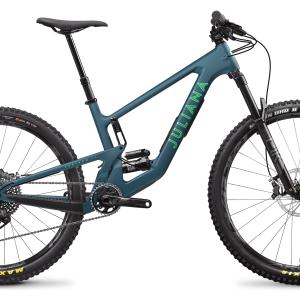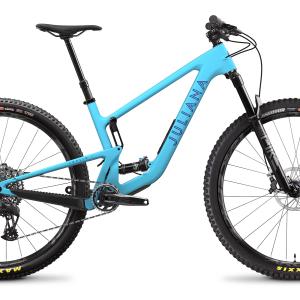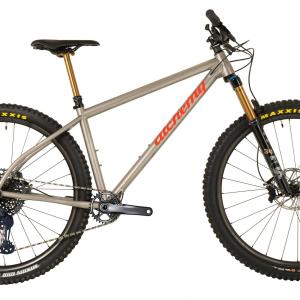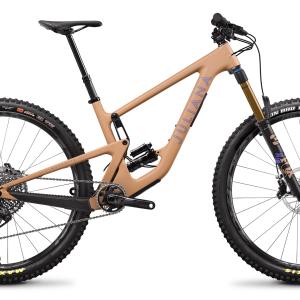2014 Cannondale Trigger 29 Carbon 1
(discontinued)
| Where To Buy | |||
|---|---|---|---|
Free shipping on orders over $50 (continental U.S. only).
International shipping available. Some exclusions apply. |
|||
Free standard shipping on orders of $50 or more (U.S. only).
International shipping available. Free on orders of $150 or more. Some exclusions apply. |
|||
Free shipping on orders over $50 (continental U.S. only).
International shipping available. Some exclusions apply. |
|||
Reviewed by John Hauer and Jess Pedersen // Photos by Shawn Spomer and Lear Miller
New for 2014, the Cannondale Trigger 29 is offered in a carbon version. By switching to carbon from aluminum, they were able to save an impressive 550 grams (1.2-pounds) off the frame weight. Sporting the rather unorthodox looking Lefty SuperMax fork and a FOX DYAD RT2 pull shock, it’s sure to make others look twice. With the flip of a switch, the custom shock transforms the ride from a 130mm trail crusher to one with just 80mm of rear travel and steeper angles ready to haul you up the hills. Curious to see how the uniqueness of the bike plays out on the trail, we tackled the best of Sedona, Arizona’s red hills aboard the Trigger 29 Carbon 1 during the 2014 Vital MTB Test Sessions.

Trigger 29 Carbon 1 Highlights
- Ballistec Hi-Mod Carbon frame
- 29-inch wheels
- 130/80mm (5.1/3.1-inches) adjustable rear wheel travel via remote
- 1.5-inch head tube
- 69-degree head angle (S, M) or 69.5-deg head angle (L, XL)
- 73.5-degree seat tube angle
- 348mm (13.7-inch) bottom bracket height
- 448mm (17.6-inch) chainstay length
- PF30 bottom bracket
- 142 x 12mm thru-axle
- Measured weight (size Large, no pedals): 26-pounds 5-ounces (11.94kg)
- $8,120 MSRP
Up front, the Trigger 29 is equipped with the Cannondale developed Lefty SuperMax Carbon PBR fork. It features 130mm of travel and a unique dual-crown, single-leg inverted design. How did they pull this off? For starters, the fork uses a 36mm diameter stanchion and 46mm carbon fiber upper leg. The hidden top portion of the stanchion is square-shaped, which prevents the two tubes from rotating relative to each other and is key to retaining torsional stiffness. Internally, the stanchion slides on four sets of needle bearings rather than bushings, reducing stiction when loaded. This design requires a proprietary hub and tapered axle.

It may surprise you, but the 4-pound (1,830 gram) fork is actually as torsionally stiff as many downhill forks while at the same time being lighter than most trail forks. As proof, take a moment to watch this demonstration videoor look over the figures below.

An integrated bumper protects the fork and frame from damage. Unlike previous versions, this model of the Lefty has been modified to allow the use of stems as short as 50mm without bar/top cap interference issues, and the steerer tube now measures a true 1.5-inches for greater stem and headset compatibility. The “PBR” edition of the fork features a Push Button platform “lockout” nestled within the top cap Rebound adjuster. Seeking a bike that could provide stability at high speeds but also handle as well as one with steeper angles at lower speeds, they chose to kick the head angle out a bit and increase the fork’s rake measurement to 61mm (compared to a typical 45-51mm).
Out back, the swingarm and linkage are based around what Cannondale calls their “Zero Pivot” and "Enhanced Center Stiffness–Torsion Control" systems. The premise is simple, and comes down to the simple fact that a frame is only as stiff as its weakest link. The single pivot and rocker link design is coupled with carbon stays that are engineered to flex vertically every compression, eliminating the need for a pivot near the rear axle like what is found on the aluminum Trigger 29. To really beef up the rear end, 15mm thru-axles are used at the remaining pivots combined with widely spaced bearings and a collet sleeve bearing preload system. The lower pivot axle is clamped by bolts on both sides. Finally, they double-stack bearings in each rear pivot to increase resistance to twisting loads.

Rear suspension wise, things get really interesting thanks to the use of a proprietary pull shock. Developed in conjunction with FOX, the DYAD RT2 offers handlebar remote cable-actuated travel adjustment from 130mm (known as "Flow" mode) to 80mm ("Elevate" mode). Setup requires the use of a Cannondale supplied high-pressure shock pump. To really envision what's going on, it's best to think of the DYAD RT2 as two separate shocks combined into one. Depending on the handlebar remote setting, the oil displaced by the center pull chamber will go into one or both sides.

In "Flow" mode the bike gets the full 130mm of travel and utilizes both positive air chambers and its own damping circuit. Doing so yields a high-volume air shock and more linear feel.
In "Elevate" mode the bike gets just 80mm of travel. This occurs because the shock is trying to pump all of the available oil into just one chamber and there simply isn't enough volume. As a result the sag point changes and the spring rate becomes more progressive. This steepens the bike's sagged head and seat tube angles, picks the bottom bracket up a bit, and provides a firmer pedaling platform.
The two modes have different compression and rebound damping characteristics. High-speed rebound and compression are factory-tuned, but low-speed rebound for both Flow and Elevate modes is user adjustable. The center chamber also includes a shared negative air chamber that affects how easily the shock compresses initially. While it may sound complicated, the shock is decently accessible and a tuning guide on the frame is a quick and easy reference.
Frame details include a direct front derailleur mount, burly derailleur hanger, 1.5-inch headtube, and a rubber chainstay protector. Cable routing is mostly external, with the derailleur, brake, and dropper post housing following the underside of the downtube. The Reverb Stealth dropper post goes into the base of the seat tube, and the rear shock cable routes internally through the side of the headtube. Cannondale licenses the Syntace X-12 142mm width rear axle system and uses ballistic carbon to increase the strength and stiffness of the frame. Despite the XX1 drivetrain spec, the frame still has ISCG tabs if you want to add a chainguide to ensure you never drop a chain. The shock positioning leaves room for a water bottle cage inside the frame. Mud clearance is decent with a minimum of 1cm of room for the much with the stock 2.35-inch Schwalbe tire.
The Trigger 29 is available in both carbon and aluminum varieties. The high-end Trigger 29 Carbon 1 retails for $8,120 (tested), while a more affordable Carbon 2 version comes in at $6,170. Aluminum models run $4,120 and $3,170.
On The Trail
We rode the Trigger 29 on a diverse selection of Sedona trails in a variety of different conditions. From slippery snow covered climbs to steep descents with slickrock, massive g-outs, rough rock gardens, tight technical maneuvers, and enough corners to make you dizzy, we rode it all. Trails included Slim Shady, Hi-Line, Little Horse, High on the Hogs, Pig Tail, and Broken Arrow.
Sporting the longest top tube in our 25 bike Test Session lineup at 634mm (25-inches), throwing a leg over the size Large test bike we immediately felt slightly more stretched out than normal. The 447mm (17.6-inch) reach is pretty lengthly too. Combined with the stock 60mm stem and modestly wide 740mm bars, this made for a stable ride well-suited to fast terrain and climbs. The bike feels a bit like a stretched out XC rig with a few extra millimeters of travel. This isn’t exactly a negative though, because with the dual travel set up it basically takes it from an XC ripper to a bike that doesn’t mind rallying when the trail gets rough.

The massive 2.35-inch Schwalbe Hans Dampf tires and long wheel base inspired a good deal of confidence on most descents, and we’d happily charge into just about anything knowing that we’d make it through unscathed. Bulldozing through moderately pitched rough terrain came naturally and the bike ate most of it up. With its 69.5-degree head angle, the Trigger is a degree or two steeper than many other aggressive 29-inch trail bikes, at least among current designs. That made truly steep terrain feel a bit sketchy and the fork didn’t absorb square edged hits as well as it could have.
On the flip side, the quick front end handling due to the head angle and increased fork offset made it very manageable as things slowed down. We were able to balance, regain composure, and get over that last rock or through a tight switchback with ease. While it felt quick and snappy in tight corners at slow speeds, at higher speeds the Trigger seemed to excel in a straight line. When the trail turned frequently the length became a bit of a burden, and any quick changes in direction took some brute force and advanced planning to bring the back end around. Once committed, though, the bike tracks well when pushing the bars down and laying into fast/smooth corners. The chainstays also felt long when trying to get the front end up on quick drops and manuals.
Stiffness in the center of the frame left a little to be desired. Flex was apparent when sprinting out of corners and during g-outs or the occasional landing where the frame wasn’t pointed straight. When airborne or about to hit something abrupt we’d find ourselves hoping the bike came out pointing in the right direction. This did seem to aid in traction around flat rough corners, however. Despite having only one leg, the Lefty fork was deceptively stiff on the trail, backing up Cannondale’s claims. This amplified the perception of the rear end flexing. On rocky descents the front end sometimes felt as though it was deflecting more than normal, but you could push into it with authority and the response was impressive.

Oddly, the fork seemed to hit a bit of a wall midway through its travel. Throughout all of our rides we were only able to use about 70% of the available travel despite some rather large impacts and conservative pressure settings according to Cannondale’s setup guide. Activating the “Pop Top” adjustment made no perceptible difference, leading us to believe that the fork may have been stuck in the firmer compression mode. It seemed to lack the superb suppleness touted in the sales material, but we did appreciate the consistency through rough off camber sections where traditional designs sometimes suffer from bushing bind issues.
Starting one of our rides on an early winter morning at 28-degrees Fahrenheit, we found the fork to be extremely sensitive to temperature when it seemed afraid to move even with the rebound wide open. Once the sun came out and the fork warmed up from riding things improved, but later in the day when the temperatures dropped and the wind picked up it began to have issues again.
Rear suspension performance was surprisingly good for a 130mm bike with no obvious problems keeping up with the trail or our riding styles, though we wouldn't classify it as being significantly better than many traditional designs. Some additional compliance over square edges and chatter would improve the experience, but overall we found it to be sufficiently active. The regressive then progressive leverage curve provided support when needed further into the stroke.

The DYAD RT2 rear shock’s on-the-fly travel adjust proved to be quite effective. At 26.3-pounds the bike is definitely on the light end of things according to the scale, but it doesn’t feel as light on the trail as you’d expect. Without the travel adjust the bike feels sluggish out of corners and when you stand up to hammer on the pedals, almost as though the brakes are rubbing or the tires are loosing air. A lot of that may come from the massive tire width. Because of this the ability to shorten the travel from 130 to 80mm for efficiency purposes is greatly appreciated, and you immediately feel the extra zip in every pedal stroke. The bike climbed like a champ in the shorter travel mode, though it does lose some compliance and traction in rough technical sections.
Changing travel modes may seem awkward at first until you realize how to best use the adjustment lever, and after that it becomes natural and surprisingly quick to do. Pushing with your thumb puts the bike in the shorter travel mode, and depressing the silver button at the end of lever returns it to the longer travel position. It’s easiest to rock your hand over and use the side of your pointer finger to return to the longer travel mode rather than once again reaching up with your thumb.
Build Kit
Cannondale’s component choices on the Trigger 29 Carbon 1 model contributed positively to the ride experience. Parts from Schwalbe, Mavic, RockShox, Magura, SRAM, and some house-branded bits highlight the spec.

The 2.35-inch Schwalbe Hans Dampf tires were absolutely ripping on the descents, though when your tires work this well on the technical aspects of the trail you often give up some valuable rolling speed. Opting for a faster rolling rear tire could balance the performance and rolling resistance equation better. Hans Dampf tires in the Trailstar compound also wear quicker than most.
While the Mavic Crossmax ST 29 wheels are aluminum, they are quite light at a very reasonable 1,620 grams. When trying to flex the bike the only perceptible give came from the bottom bracket area and center of the frame. The wheels gave the tires a good profile and should be easy to keep true over time. They’re also very easy to set up tubeless thanks to the UST rim profile.
Although the Magura MT6 levers made the travel adjust lever hard to line up perfectly, they provided great control and plenty of usable power. We were impressed with their ability to remain quiet despite riding through sand and water several times. They never faded and always had the same pull and consistency.
The drivetrain is a mixture of SRAM XX1/X01 and Cannondale components. Cannondale’s own HollowGram SI cranks were used in place of SRAM’s carbon cranks, presumably to keep the cost down. Similarly, the X01 cassette is a hair less expensive while retaining the same level of performance as the XX1 equivalent. Even without a guide, we had no concerns about dropping a chain. The 30-tooth chainring and 10 to 42-tooth cassette offered plenty of gear range for the technical rocky climbs of Sedona.
The drivetrain, suspension and brakes made no noise, helping to keep the bike very quiet. Cable routing is also clean without rattling.
Long Term Durability
The Trigger 29 frame appears to be well made and down for the long haul. Our only concern is the use of a proprietary shock and fork, which may or may not be in production as long as traditional models. Given that the fork appeared to have premature issues with the pop top compression/"lockout" adjustment, we feel this is a legitimate concern. Without a Cannondale dealer nearby, service might take longer than you’d like.
Cannondale backs the frame with a lifetime warranty and components for one year should any issues arise.

What's The Bottom Line?
The Cannondale Trigger 29 Carbon excels in high speed, rolling singletrack where efficiency, traction, and the ability to blast through an occasional technical section are the primary demands. With its long top tube and massive tires it feels a bit like a bulldozer when charging the trail, but remains agile at slower speeds and climbs impressively. This is a decent all-around trail bike, and save truly steep and rowdy descents the geometry works pretty well.
As they have from day one, Cannondale continues to be bold and think outside of the box. The use of two proprietary suspension components certainly begs the question of whether or not they are being unique for the sake of it or for true performance gains. There are a lot of awesome 29-inch trail bikes on the market right now with components to match, so it’s difficult for us to recommend the Trigger 29 over some of the other class leaders, especially at this price point. One thing is certain though - it’s definitely a conversation starter.
Visit www.cannondale.com for more details.
Bonus Gallery: 34 photos of the 2014 Cannondale Trigger 29 Carbon 1 up close and in action
About The Reviewers
John Hauer - In 13 years of riding, John has done it all and done it well. Downhill, 4X, Enduro, XC, cyclocross... you name it. He spent 7 years as the head test rider for a major suspension company, averages 15-20 hours of saddle time per week, and is extremely picky when it comes to a bike's performance. And yeah, he freakin’ loves Strava.
Jess Pedersen - Jess is one of those guys that can hop on a bike after a snowy winter and instantly kill it. He's deceptively quick, smooth, and always has good style. He's also known to tinker with bikes 'til they're perfect, creating custom additions and fixes along the way. Maybe it's that engineering background...

Specifications
| Where To Buy | |||
|---|---|---|---|
Free shipping on orders over $50 (continental U.S. only).
International shipping available. Some exclusions apply. |
|||
Free standard shipping on orders of $50 or more (U.S. only).
International shipping available. Free on orders of $150 or more. Some exclusions apply. |
|||
Free shipping on orders over $50 (continental U.S. only).
International shipping available. Some exclusions apply. |
|||






















1 comments
Post a reply to: 2014 Test Sessions: Cannondale Trigger 29 Carbon 1